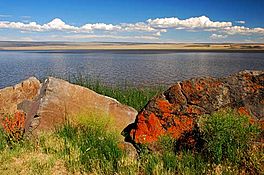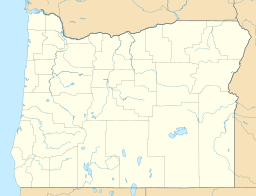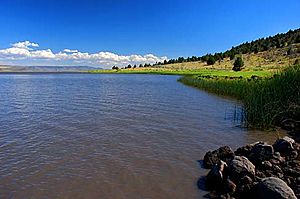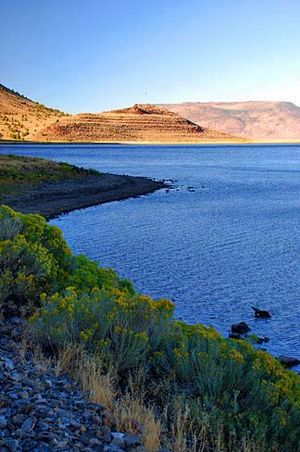Crump Lake (Oregon) facts for kids
Quick facts for kids Crump Lake |
|
|---|---|

Crump Lake shoreline
|
|
| Location | Eastern Lake County, Oregon, US |
| Coordinates | 42°17′41″N 119°49′31″W / 42.2946°N 119.8252°W |
| Lake type | Natural lake |
| Primary inflows | Deep Creek and Twelvemile Creek |
| Primary outflows | Wetland channel to Hart Lake |
| Catchment area | 835 square miles (2,160 km2) |
| Max. length | 7.2 mi (11.6 km) |
| Max. width | 2.8 mi (4.5 km) |
| Surface area | 7,680 acres (31.1 km2) |
| Average depth | 3 ft (0.91 m) |
| Max. depth | 6 ft (1.8 m) |
| Shore length1 | 70.9 mi (114.1 km) |
| Surface elevation | 4,476 ft (1,364 m) |
| 1 Shore length is not a well-defined measure. | |
Crump Lake is a large, shallow lake in southeastern Oregon, United States. It's the biggest lake in the Warner Lakes system. The lake is named after Thomas Crump, an early rancher in the area.
Crump Lake is owned by the state of Oregon. Much of the land around it is managed by the government to protect nature. The lake and its surrounding wet areas are home to many different birds and other animals. You can enjoy activities like fishing, bird watching, and camping at or near Crump Lake.
Contents
Where is Crump Lake?
Crump Lake is located about 4.5 miles (7.2 km) north of a small town called Adel, Oregon. It sits at the southern end of the Warner Valley. This valley is about 60 miles (97 km) long and 8 miles (13 km) wide.
Long ago, during the Ice Age, the entire valley was covered by one huge lake. Today, only smaller lakes remain. These lakes, including Crump Lake, are called endorheic lakes. This means their water doesn't flow out to the ocean. Instead, it just evaporates.
Crump Lake is part of a chain of lakes in the Warner Valley. Starting from the south, these lakes include Pelican Lake, Crump Lake, Hart Lake, and several others to the north. The valley gently slopes north, so Crump Lake is a bit higher than the lakes further north.
A Look Back in Time
Native Americans lived near Crump Lake for thousands of years. They used the lakes and wetlands for food and resources. You can still find ancient petroglyphs (rock carvings) near Crump Lake. Some are thought to be 12,000 years old! The Greaser Petroglyph Site, a special place with these carvings, is listed as a historic site.
In 1867, a general named George Crook needed to build a bridge. He wanted to stop Native American groups from passing through the area. So, soldiers built a bridge across a marshy channel between Crump Lake and Hart Lake. This "Stone Bridge" was actually a long causeway made of rocks. It's still there today and is also a historic site.
The lake got its name from Thomas Crump, a rancher who settled nearby in the 1890s. In 1959, a well drilled on his ranch created the Crump Geyser. Water from this geyser flows into the lake.
There used to be a small island in Crump Lake where birds nested. It disappeared during a dry period in the 1950s. In 2008, the United States Army Corps of Engineers built a new, stronger island. They covered it with sand and gravel. Now, it's a successful nesting spot for Caspian terns and other water birds.
In 2015, the lake was closed to the public for a while. This was because a long drought made the water level very low. The closure helped protect the lakebed from people looking for old artifacts. The lake reopened in 2016 when water levels improved.
Lake Environment
Crump Lake is a natural lake covering about 7,324 acres (29.64 km2). It's about 7.2 miles (11.6 km) long and 2.8 miles (4.5 km) wide. This makes it the largest of the Warner Lakes when water levels are normal.
The lake is quite shallow, with an average depth of 3 feet (0.91 m) and a maximum depth of 6 feet (1.8 m). Fresh water flows into Crump Lake from Deep Creek and Twelvemile Creek. This helps keep the water level stable. Water also flows in from Pelican Lake. The water from Crump Lake then flows north into Hart Lake.
The water in Crump Lake is often murky. This is because of tiny bits of organic material floating in it. Even so, the lake is less cloudy than many other lakes that don't have an outlet. This is because it overflows for several months each year. The lake has a lot of nutrients, like phosphorus, which means it's very rich in plant life.
Wildlife at Crump Lake
Crump Lake is a special home for many plants and animals. The land around the lake varies. To the east, it's mostly big sagebrush desert. To the south and west, you'll find marshes, meadows, and grasslands. These areas are full of marsh grasses.
You can find many animals here, including desert mammals, birds that live here all year, and birds that stop during their migrations.
Fish Species
Crump Lake is home to native fish like the Warner Valley redband trout and the Warner sucker. These fish are also found in the creeks that feed the lake. This helps them re-populate the lake after dry periods.
However, other fish like crappie, smallmouth bass, and bullhead catfish have been introduced. These non-native fish compete with the native species. Because of this, the Warner Valley redband trout and Warner sucker are now considered threatened species.
Mammals and Birds
Over forty types of mammals live around Crump Lake. You might see large animals like pronghorn, bighorn sheep, elk, mule deer, cougar, bobcat, and coyotes. Smaller mammals include jackrabbits, ground squirrels, chipmunks, skunks, and muskrats.
Many bird species also live near Crump Lake or visit during their migrations. Birds that nest here include sandhill cranes, American white pelicans, double-crested cormorants, and various ducks and terns. You can also spot white-faced ibis, great white egrets, and American avocets in the marshes.
At the nearby Warner Wetlands Interpretive Site, you can use observation areas. Here, you might see American bitterns, black-necked stilts, cinnamon teal, tundra swans, and many songbirds.
In the meadows and marshes, summer birds include dusky flycatchers, yellow warblers, and house wrens. Other birds in the valley are mountain chickadees, Cassin's finches, and different types of warblers. Larger birds of prey like great horned owls, barn owls, prairie falcons, golden eagles, and bald eagles also live in the area.
Fun Things to Do
Crump Lake and the surrounding lands offer many chances for outdoor fun. The Oregon Department of State Lands owns and manages Crump Lake. Much of the land around it is public and managed by the Bureau of Land Management. The northern part of the lake is also part of the Hart Mountain National Antelope Refuge.
You can enjoy fishing, bird watching, boating, hunting, and camping here. However, some activities depend on the lake's water levels, which can change a lot each year.
Most years, you can fish and boat on Crump Lake. People fish from the shore or use small boats and canoes. Popular fish to catch include crappie, largemouth bass, and brown bullhead.
There are no official campgrounds right at Crump Lake. But you can camp for free on the public lands managed by the Bureau of Land Management. About 10 miles (16 km) north of Crump Lake, there's the Warner Wetlands Interpretive Site. This spot has restrooms, picnic tables, birdwatching areas, and hiking trails for a day visit.




